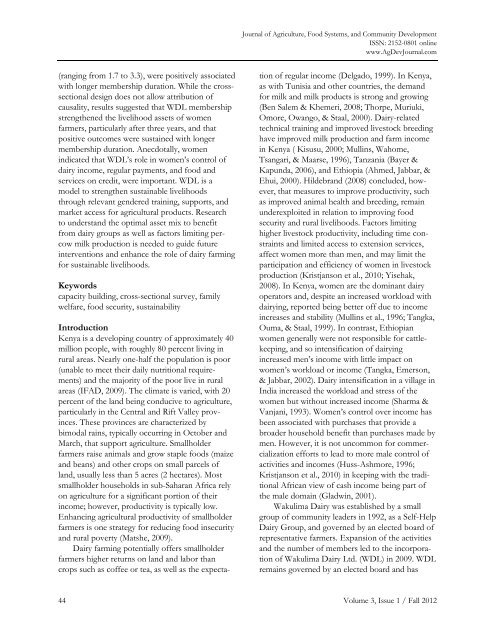Journal of Agriculture, Food Systems, and Community Development
Journal of Agriculture, Food Systems, and Community Development
Journal of Agriculture, Food Systems, and Community Development
Create successful ePaper yourself
Turn your PDF publications into a flip-book with our unique Google optimized e-Paper software.
<strong>Journal</strong> <strong>of</strong> <strong>Agriculture</strong>, <strong>Food</strong> <strong>Systems</strong>, <strong>and</strong> <strong>Community</strong> <strong>Development</strong><br />
ISSN: 2152-0801 online<br />
www.AgDev<strong>Journal</strong>.com<br />
(ranging from 1.7 to 3.3), were positively associated<br />
with longer membership duration. While the crosssectional<br />
design does not allow attribution <strong>of</strong><br />
causality, results suggested that WDL membership<br />
strengthened the livelihood assets <strong>of</strong> women<br />
farmers, particularly after three years, <strong>and</strong> that<br />
positive outcomes were sustained with longer<br />
membership duration. Anecdotally, women<br />
indicated that WDL’s role in women’s control <strong>of</strong><br />
dairy income, regular payments, <strong>and</strong> food <strong>and</strong><br />
services on credit, were important. WDL is a<br />
model to strengthen sustainable livelihoods<br />
through relevant gendered training, supports, <strong>and</strong><br />
market access for agricultural products. Research<br />
to underst<strong>and</strong> the optimal asset mix to benefit<br />
from dairy groups as well as factors limiting percow<br />
milk production is needed to guide future<br />
interventions <strong>and</strong> enhance the role <strong>of</strong> dairy farming<br />
for sustainable livelihoods.<br />
Keywords<br />
capacity building, cross-sectional survey, family<br />
welfare, food security, sustainability<br />
Introduction<br />
Kenya is a developing country <strong>of</strong> approximately 40<br />
million people, with roughly 80 percent living in<br />
rural areas. Nearly one-half the population is poor<br />
(unable to meet their daily nutritional requirements)<br />
<strong>and</strong> the majority <strong>of</strong> the poor live in rural<br />
areas (IFAD, 2009). The climate is varied, with 20<br />
percent <strong>of</strong> the l<strong>and</strong> being conducive to agriculture,<br />
particularly in the Central <strong>and</strong> Rift Valley provinces.<br />
These provinces are characterized by<br />
bimodal rains, typically occurring in October <strong>and</strong><br />
March, that support agriculture. Smallholder<br />
farmers raise animals <strong>and</strong> grow staple foods (maize<br />
<strong>and</strong> beans) <strong>and</strong> other crops on small parcels <strong>of</strong><br />
l<strong>and</strong>, usually less than 5 acres (2 hectares). Most<br />
smallholder households in sub-Saharan Africa rely<br />
on agriculture for a significant portion <strong>of</strong> their<br />
income; however, productivity is typically low.<br />
Enhancing agricultural productivity <strong>of</strong> smallholder<br />
farmers is one strategy for reducing food insecurity<br />
<strong>and</strong> rural poverty (Matshe, 2009).<br />
Dairy farming potentially <strong>of</strong>fers smallholder<br />
farmers higher returns on l<strong>and</strong> <strong>and</strong> labor than<br />
crops such as c<strong>of</strong>fee or tea, as well as the expectation<br />
<strong>of</strong> regular income (Delgado, 1999). In Kenya,<br />
as with Tunisia <strong>and</strong> other countries, the dem<strong>and</strong><br />
for milk <strong>and</strong> milk products is strong <strong>and</strong> growing<br />
(Ben Salem & Khemeri, 2008; Thorpe, Muriuki,<br />
Omore, Owango, & Staal, 2000). Dairy-related<br />
technical training <strong>and</strong> improved livestock breeding<br />
have improved milk production <strong>and</strong> farm income<br />
in Kenya ( Kisusu, 2000; Mullins, Wahome,<br />
Tsangari, & Maarse, 1996), Tanzania (Bayer &<br />
Kapunda, 2006), <strong>and</strong> Ethiopia (Ahmed, Jabbar, &<br />
Ehui, 2000). Hildebr<strong>and</strong> (2008) concluded, however,<br />
that measures to improve productivity, such<br />
as improved animal health <strong>and</strong> breeding, remain<br />
underexploited in relation to improving food<br />
security <strong>and</strong> rural livelihoods. Factors limiting<br />
higher livestock productivity, including time constraints<br />
<strong>and</strong> limited access to extension services,<br />
affect women more than men, <strong>and</strong> may limit the<br />
participation <strong>and</strong> efficiency <strong>of</strong> women in livestock<br />
production (Kristjanson et al., 2010; Yisehak,<br />
2008). In Kenya, women are the dominant dairy<br />
operators <strong>and</strong>, despite an increased workload with<br />
dairying, reported being better <strong>of</strong>f due to income<br />
increases <strong>and</strong> stability (Mullins et al., 1996; Tangka,<br />
Ouma, & Staal, 1999). In contrast, Ethiopian<br />
women generally were not responsible for cattlekeeping,<br />
<strong>and</strong> so intensification <strong>of</strong> dairying<br />
increased men’s income with little impact on<br />
women’s workload or income (Tangka, Emerson,<br />
& Jabbar, 2002). Dairy intensification in a village in<br />
India increased the workload <strong>and</strong> stress <strong>of</strong> the<br />
women but without increased income (Sharma &<br />
Vanjani, 1993). Women’s control over income has<br />
been associated with purchases that provide a<br />
broader household benefit than purchases made by<br />
men. However, it is not uncommon for commercialization<br />
efforts to lead to more male control <strong>of</strong><br />
activities <strong>and</strong> incomes (Huss-Ashmore, 1996;<br />
Kristjanson et al., 2010) in keeping with the traditional<br />
African view <strong>of</strong> cash income being part <strong>of</strong><br />
the male domain (Gladwin, 2001).<br />
Wakulima Dairy was established by a small<br />
group <strong>of</strong> community leaders in 1992, as a Self-Help<br />
Dairy Group, <strong>and</strong> governed by an elected board <strong>of</strong><br />
representative farmers. Expansion <strong>of</strong> the activities<br />
<strong>and</strong> the number <strong>of</strong> members led to the incorporation<br />
<strong>of</strong> Wakulima Dairy Ltd. (WDL) in 2009. WDL<br />
remains governed by an elected board <strong>and</strong> has<br />
44 Volume 3, Issue 1 / Fall 2012






